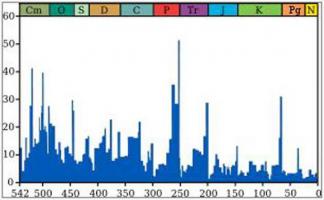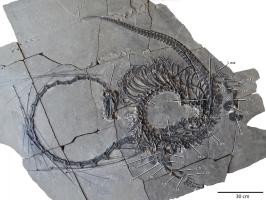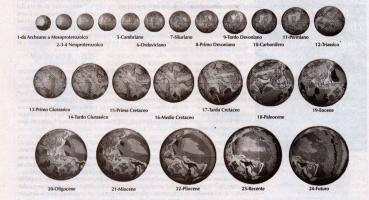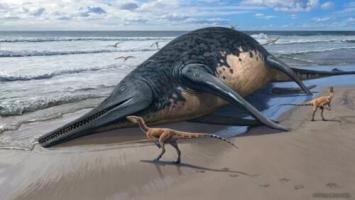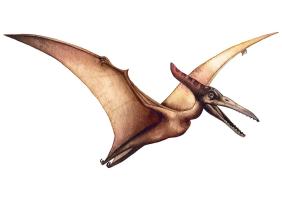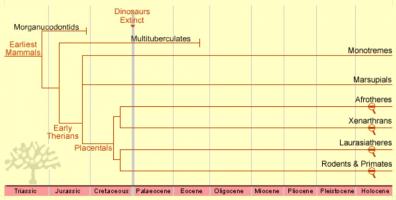Triassic
225 to 190 million years ago
With the Triassic period opens the Mesozoic Era ("of the middle life"), or secodary era. Why was it decided to underline, with a clear division, the passage from the Permian to the Triassic, even opening a new geological era, the one that, with a picturesque term, is also called "the Middle Ages of the Earth"? Today we can say that, if there are many "novelties" in the Triassic, many are also the elements that constitute a continuous "bridge" with the preceding penode. In the past, however, scholars have mainly focused on some phenomena (especially on the disappearance of various animal groups) and have seen in these signs the indication of a great "turning the page" in the book of the Earth. The Pangea is still a single block but the arm of the sea of the Tethys extends and separates the northern part (Laurasia) from the southern part (Gondwana). Various rifts also open which will later isolate the continents. The climate is mainly hot and dry. The desert areas are many but, in them, vast oases are formed. In the Triassic even plants without flowers began to form. Let's move on to the animal world in the seas the trilobites disappear completely. The dominant corals in the Paleozoic. The development of the ammonites is enormous and that of the Belemnites is remarkable, molluscs with a characteristic inicrua shell with a spear point, perhaps similar to cuttlefish in their external appearance. Sharks are well documented (of which only the teeth are found, of course, since the skeleton of cartilages was rapidly decomposing). These animals "demonstrate" that the cartilage skeleton can be an excellent support element in an environment that it "supports" with the hydrostatic thrust (of Archimedes); it also has the considerable advantage of being light. Bony fish, on the other hand "show" that the bone structures, heavier than the cartilaginous ones, are however very robust and the effect of their weight can be balanced by the presence of the swim bladder (which no shark or ray will ever have). Bony fish are abundant in the Triassic but not yet as dominant as in present-day seas. New imposing development of the Brachiopods: some of these forms will come down to us. Strong reduction of sea lilies and significant development of sea urchins. Whole waters are populated by bony fish, gastropod molluscs, crustaceans.
The reptiles begin to play, in the Triassic, a game in which they seem to have all the aces, the jokers, plus some other good hidden cards: they win everywhere and always. They come in a wide variety of forms; and all this in a world where amphibians are still in the breach.

The largest of all the Labyrinthodont amphibians are documented in the Triassic period: certain forms of the genera Mastodonsaurus, Capitosaurus, and Trematosaurus, are up to 5 m long. The relationship with the aquatic environment, and in particular with the sea, continued to act, in reptiles, as a powerful evolutionary stimulus. Ichthyosaurs developed, reptiles suitable for swimming in the open sea, hunters of fish and ammonites; the Placodonti, with typical "front teeth" perhaps suitable for detaching bivalve molluscs from rocks and flat teeth for grinding hard materials, therefore also shells; the Notosaurs, forms with a serpentine neck and legs with distinct toes but joined by a membrane (like those of ducks). It is probable that the notosaurs spent a good part of their time on the cliffs from which they then plunged into the water to fish: in short, they lived like the current walruses. There were also forms whose structure "anticipates" that of today's crocodiles. In the mainland environments of the Triassic the direct ancestors of the true lizards (genus Prolacerta) developed. These environments were still dominated, at least in the first part of the period, by the Therapsids (or "paramammilers"). The Lystrosaurus and other similar forms acted in the areas covered with vegetation near the swamps, with life habits similar to those of the current hippos. Among the Triassic reptiles active on land we are interested in an animal just under 1 m long, bipedal and rather agile. It walks on the "hind legs", more robust than the "arms", balancing the weight of the front of the body with the long muscular tail that it keeps raised from the ground. It is the Euparkeria. Probably it is the heir of the first descendants (Cotylosaurs) of the most ancient reptiles (such as Hylonomus): that is, it already has a long history behind it. Its skull is quite large (the jaws are strong), but the bone structure is lightened by large empty areas (fenestrations); in particular there is a cavity between that of the orbit (where the eyes are housed) and that of the nostril: in this cavity, perhaps, there was a "salt" gland. A similar organ exists today in reptiles and birds living in arid areas: it serves to eliminate the excess of salts accumulated in the organism. This type of skull is found today only in crocodiles, but in the past it has characterized all the great reptiles collectively called Arcosaurs ("dominating lizards") and, in particular, the "dinosaurs". The vast array of archosaurs can be divided into five groups. The first is that of the Tecodonti, relatively primitive forms and of modest size: the Euparkeria is one of the most evolved tecodonti, with various characteristics that "anticipate" those of real dinosaurs. Another group is that of the Crocodiles, the only archosaurs surviving to this day. Then there is the group of Pterosaurs, flying forms which we will deal with later. Finally, the two groups of dinosaurs. Why are we talking about two groups regarding these reptiles? Because these archosaurs have two different types of basin that allow us to distinguish two evolutionary strands.

In Saurischi dinosaurs ("with the lizard's hip") the pelvis bone called pubis protrudes forward: the same structure as with a saurischi basin, the Euparkeria is included in the relatively primitive group of Tecodonti archosaurs. From forms similar to Ornithosuchus came the large predatory saurischi dinosaurs called Carnosaurs. The first true saurisks are the Celurosaurs, predators, well exemplified by the Coelophysis (late Triassic), of medium size and very slender.










